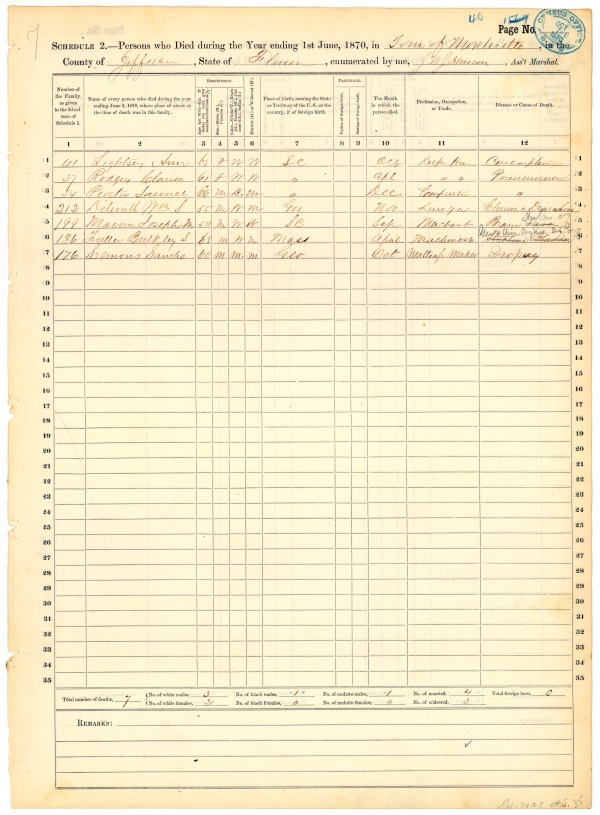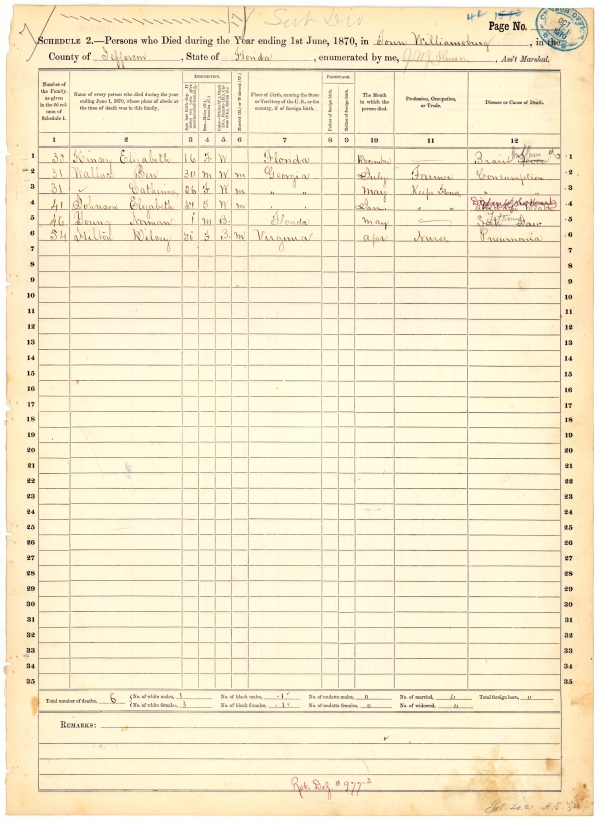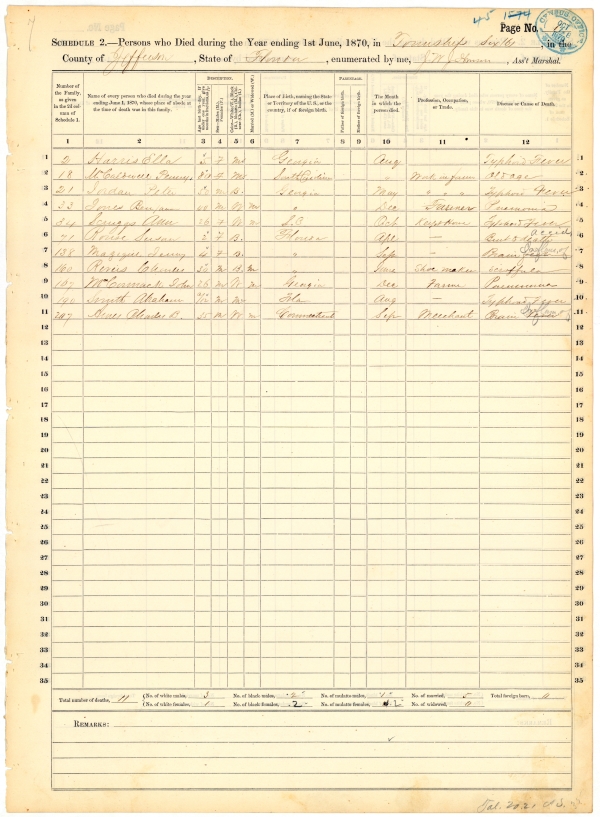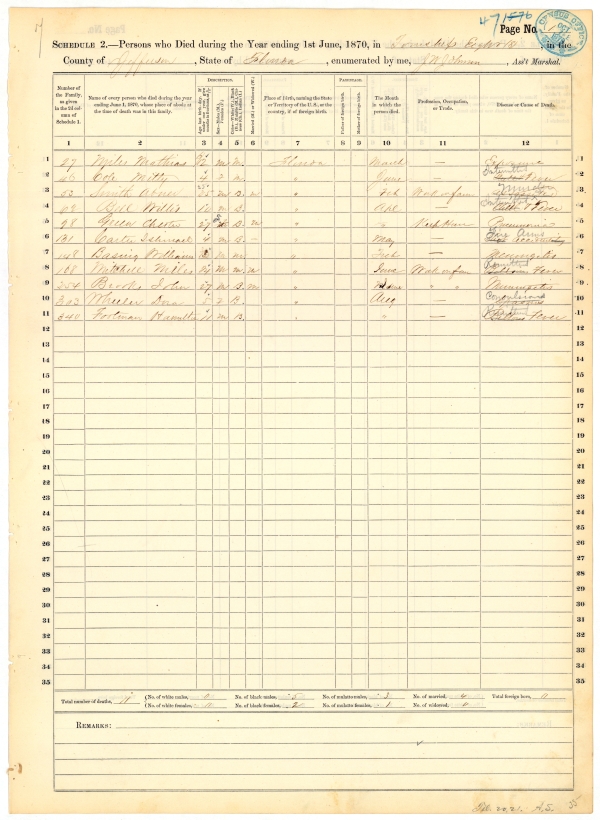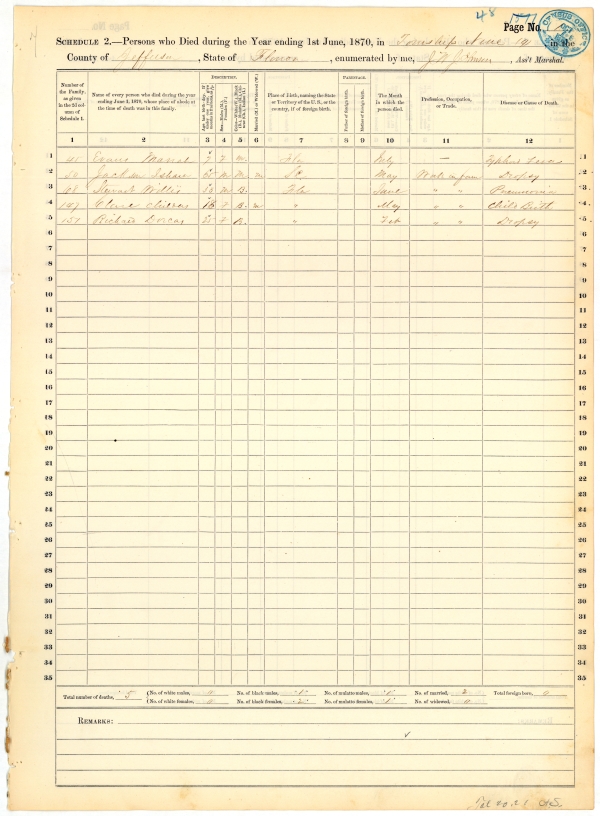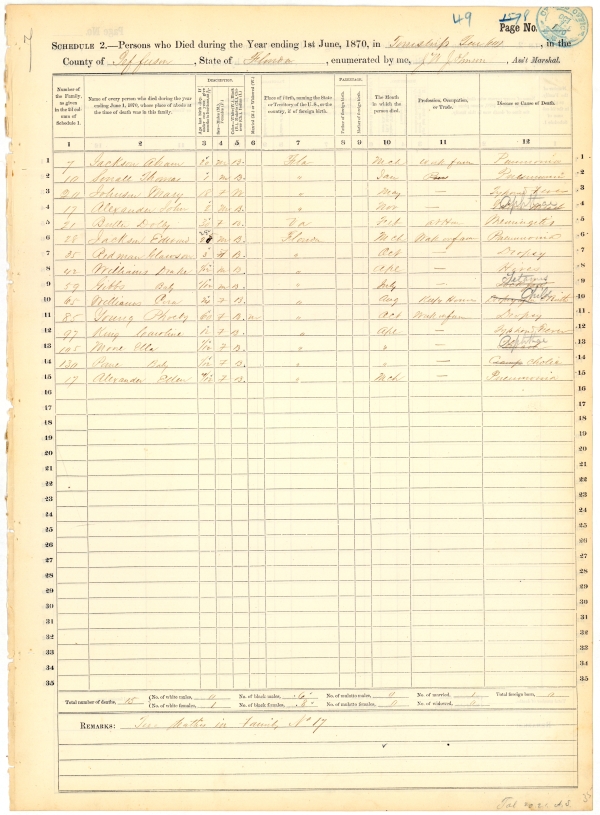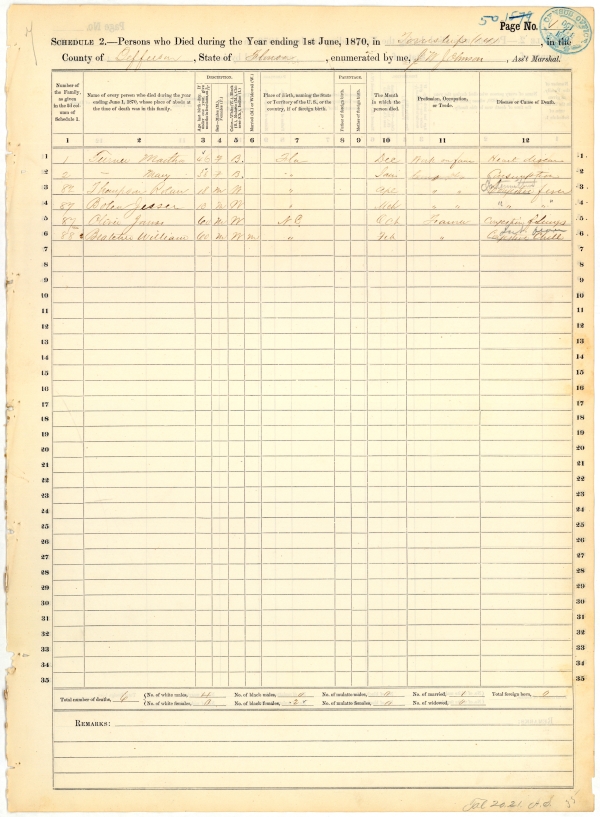Florida Memory is administered by the Florida Department of State, Division of Library and Information Services, Bureau of Archives and Records Management. The digitized records on Florida Memory come from the collections of the State Archives of Florida and the special collections of the State Library of Florida.

State Archives of Florida
- ArchivesFlorida.com
- State Archives Online Catalog
- ArchivesFlorida.com
- ArchivesFlorida.com
State Library of Florida
Related Sites
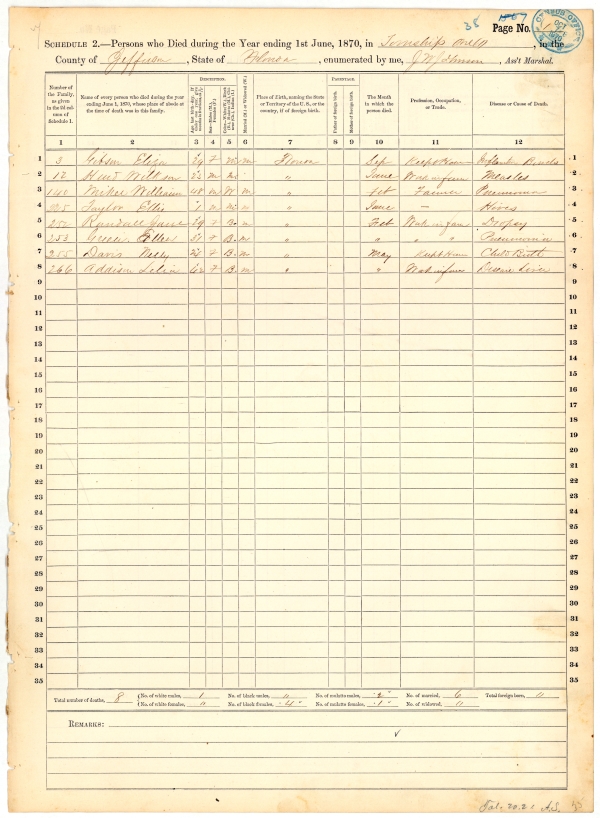
Description of previous item
Description of next item

Source
Description
Date
Contributors
Format
Personal Subjects
Addison, Lelia, ca.1808-ca.1870
Alexander, Ellen, ca.1870-ca.1870
Alexander, John, ca.1868-ca.1870
Ames, Charles, ca.1835-ca.1870
Basing, William, ca.1855-ca.1870
Beatcher, William, ca.1810-ca.1870
Bell, Willis, ca.1769-ca.1870
Black, Joe, ca.1820-ca.1870
Bolen, Jessee, ca.1857-ca.1870
Brannon, Milly, ca.1840-ca.1870
Brooker, Richard, ca.1844-ca.1870
Brooks, John M., ca.1843-ca.1870
Butler, Dolly, ca.1840-ca.1870
Butler, Tebithus, ca.1748-ca.1870
Butler, Violet, ca.1765-ca.1870
Carter, Ishmael, ca.1866-ca.1870
Clare, Childers, ca.1852-ca.1870
Cole, Mitty, ca.1866-ca.1870
Cuthbert, Thomas, ca.1838-ca.1870
Dallas, Lucinda, ca.1814-ca.1870
Dallas, Spencer, ca.1846-ca.1870
Davis, Nelly, ca.1846-ca.1870
Delilvath, William S., ca.1815-ca.1870
Epps, Thomas J., ca.1830-ca.1870
Evans, Manah, ca.1863-ca.1870
Firtcherchain, Robert, ca.1869-ca.1870
Footman, Hamilton, ca.1859-ca.1870
Foy, Sarah, ca.1863-ca.1870
Fuller, Bulkley S., ca.1807-ca.1870
Gardner, Henderson, ca.1869-ca.1870
Gibbs, [Infant], ca.1870-ca.1870
Gibson, Eliza, ca.1841-ca.1870
Goodin, Hobey, ca.1798-ca.1870
Green, Chester, ca.1843-ca.1870
Green, Ellen, ca.1839-ca.1870
Griffin, Anthony, ca.1820-ca.1870
Hall, Anna E., ca.1845-ca.1870
Harris, Ella, ca.1865-ca.1870
Hilton, Dilsey, ca.1820-ca.1870
Hodge, James, ca.1868-ca.1870
Hughes, Edgar, ca.1840-ca.1870
Hurd, Wilkson, ca.1847-ca.1870
Jackson, Abram, ca.1850-ca.1870
Jackson, Edwin, ca.1845-ca.1870
Jackson, Isham, ca.1805-ca.1870
Johnson, Elizabeth, ca.1816-ca.1870
Johnson, Mary, ca.1852-ca.1870
Jones, Benjamin, ca.1830-ca.1870
Jordan, Peter, ca.1820-ca.1870
King, Caroline, ca.1858-ca.1870
Kinsey, Elizabeth, ca.1854-ca.1870
Lemons, Sancho, ca.1810-ca.1870
Lightsey, Ann, ca.1807-ca.1870
Marshal, Jacob, ca.1867-ca.1870
Marvin, Joseph M., ca.1820-ca.1870
Mazique, Jenny, ca.1866-ca.1870
McCaldwell, Penny, ca.1790-ca.1870
McCormack, John, ca.1844-ca.1870
McDaniel, Daniel, ca.1815-ca.1870
McQueen, Candas, ca.1865-ca.1870
Mikel, William, ca.1822-ca.1870
Miles, Mathias, ca.1870-ca.1870
Mitchell, Miles, ca.1846-ca.1870
Moore, Ella, ca.1870-ca.1870
Noble, Dock, ca.1864-ca.1870
Ntsy, Ben, ca.1870-ca.1870
Oliver, James, ca.1810-ca.1870
Pane, [Infant], ca.1870-ca.1870
Paramore, John, ca.1844-ca.1870
Pond, Daniel, ca.1800-ca.1870
Proctor, Samuel, ca.1804-ca.1870
Randall, Jane, ca.1841-ca.1870
Randolph, Emma, ca.1870-ca.1870
Redman, Glawson, ca.1867-ca.1870
Richard, Dorcas, ca.1845-ca.1870
Rivers, Charles, ca.1840-ca.1870
Robinson, George, ca.1835-ca.1870
Rodgers, Clarisa, ca.1809-ca.1870
Rouse, Susan, ca.1868-ca.1870
Salter, Henry, ca.1870-ca.1870
Sarlinger, Berry, ca.1838-ca.1870
Sciplin, Nancy, ca.1869-ca.1870
Scott, Martha, ca.1870-ca.1870
Scruggs, Ann, ca.1844-ca.1870
Shaw, Thomas, ca.1856-ca.1870
Sinale, Thomas, ca.1869-ca.1870
Singleton, John, ca.1805-ca.1870
Smith, Abner, ca.1845-ca.1870
Smith, Abraham, ca.1870-ca.1870
St. Johns, Ida, ca.1866-ca.1870
Stewart, Willis, ca.1837-ca.1870
Stripling, Ben, ca.1870-ca.1870
Taylor, Candas, ca.1810-ca.1870
Taylor, Ellis, ca.1869-ca.1870
Tench, Anna, ca.1830-ca.1870
Thompson, Rolan, ca.1852-ca.1870
Tillman, Louisa, ca.1832-ca.1870
Turnbull, John, ca.1868-ca.1870
Turner, Martha, ca.1824-ca.1870
Turner, Mary, ca.1832-ca.1870
Tyson, Richard, ca.1868-ca.1870
Vann, William, ca.1850-ca.1870
Wallace, Ben, ca.1840-ca.1870
Wallace, Catherine, ca.1844-ca.1870
Wheeler, Dora, ca.1865-ca.1870
Whitehurst, Ellen, ca.1863-ca.1870
Whitehurst, Mahala, ca.1816-ca.1870
Whitehurt, A. J., ca.1817-ca.1870
Williams, Cora, ca.1846-ca.1870
Williams, Dandy, ca.1835-ca.1870
Williams, Drake, ca.1870-ca.1870
Young, Norman, ca.1869-ca.1870
Young, Phoeby, ca.1810-ca.1870
Geographic Term
| Page | Line | Name | Age | Sex | Race | Cause of Death | Notes |
|---|---|---|---|---|---|---|---|
| 1 | 1 | Gibson, Eliza | 29 years | Female | Mulatto | Inflamation of bowels | |
| 1 | 2 | Hurd, Wilkson | 23 years | Male | Mulatto | Measles | |
| 1 | 3 | Mikel, William | 48 years | Male | White | Pneumonia An infection of the lungs characterized by inflammation and a buildup of fluid that makes it difficult to breathe (Hooper, Lexicon Medicum, 1860). | |
| 1 | 4 | Taylor, Ellis | 1 year | Male | Mulatto | Hives Although hives are now generally defined as a rash of itchy red welts on the skin, in the 1800s the term was synonymous with cynanche trachealis, or the croup. The use of the term “hives” in this case is a corruption of the word “heaves,” which describes the patient’s spasmodic convulsions as they attempted to breathe (Mortality Statistics of the Seventh Census of the United States, 1855). | |
| 1 | 5 | Randall, Jane | 29 years | Female | Black | Dropsy A general term meaning the accumulation of fluid in some part of the body. A diagnosis of “dropsy” often meant the condition was prevalent throughout the body, while a case in which the accumulation of fluid was more localized might receive a more specific diagnosis. Examples include dropsy of the belly (ascites), the brain (hydrocephalus), the chest (hydrothorax), or the skin (anasarca) (Hooper, Lexicon Medicum, 1860). | |
| 1 | 6 | Green, Ellen | 31 years | Female | Black | Pneumonia An infection of the lungs characterized by inflammation and a buildup of fluid that makes it difficult to breathe (Hooper, Lexicon Medicum, 1860). | |
| 1 | 7 | Davis, Nelly | 24 years | Female | Black | Childbirth | |
| 1 | 8 | Addison, Lelia | 62 years | Female | Black | Disease liver | |
| 2 | 1 | Sarlinger, Berry | 32 years | Male | White | Consumption Another name for tuberculosis, a bacterial infection of the lungs. | |
| 2 | 2 | Griffin, Anthony | 50 years | Male | Mulatto | Typhoid fever | |
| 2 | 3 | Shaw, Thomas | 14 years | Male | White | Typhoid fever | |
| 2 | 4 | Pond, Daniel | 70 years | Male | White | Pneumonia An infection of the lungs characterized by inflammation and a buildup of fluid that makes it difficult to breathe (Hooper, Lexicon Medicum, 1860). | |
| 3 | 1 | Lightsey, Ann | 63 years | Female | White | Consumption Another name for tuberculosis, a bacterial infection of the lungs. | |
| 3 | 2 | Rodgers, Clarisa | 61 years | Female | White | Pneumonia An infection of the lungs characterized by inflammation and a buildup of fluid that makes it difficult to breathe (Hooper, Lexicon Medicum, 1860). | |
| 3 | 3 | Proctor, Samuel | 66 years | Male | Black | Pneumonia An infection of the lungs characterized by inflammation and a buildup of fluid that makes it difficult to breathe (Hooper, Lexicon Medicum, 1860). | |
| 3 | 4 | Delilvath, William S. | 55 years | Male | White | Chronic diarrhea | |
| 3 | 5 | Marvin, Joseph M. | 50 years | Male | White | Inflammation of brain | |
| 3 | 6 | Fuller, Bulkley S. | 63 years | Male | White | Gen. & urin. organs disease | |
| 3 | 7 | Lemons, Sancho | 60 years | Male | Mulatto | Dropsy A general term meaning the accumulation of fluid in some part of the body. A diagnosis of “dropsy” often meant the condition was prevalent throughout the body, while a case in which the accumulation of fluid was more localized might receive a more specific diagnosis. Examples include dropsy of the belly (ascites), the brain (hydrocephalus), the chest (hydrothorax), or the skin (anasarca) (Hooper, Lexicon Medicum, 1860). | |
| 4 | 1 | Epps, Thomas J. | 40 years | Male | White | Disease brain | |
| 4 | 2 | Hughes, Edgar | 30 years | Male | White | Consumption Another name for tuberculosis, a bacterial infection of the lungs. | |
| 4 | 3 | Scott, Martha | 2 months | Female | Black | Diarrhea Family members, census takers, and even medical professionals often gave this as a cause of death for any disease where the deceased had suffered from a prolonged intestinal complaint and a more specific diagnosis could not be made. | |
| 4 | 4 | Robinson, George | 35 years | Male | White | Disease brain | |
| 4 | 5 | Tyson, Richard | 2 years | Male | Black | Intermittent fever | |
| 4 | 6 | Tench, Anna | 40 years | Female | Black | Pneumonia An infection of the lungs characterized by inflammation and a buildup of fluid that makes it difficult to breathe (Hooper, Lexicon Medicum, 1860). | |
| 4 | 7 | Noble, Dock | 6 years | Male | Black | Scrofula Tuberculosis occurring outside the lungs, typically in the form of glandular tumors in the neck. These tumors could become ulcerated, and the tuberculosis infection could spread to the lungs (McGown, A Practical Treatise on the Most Common Diseases of the South, 1849). | |
| 5 | 1 | Black, Joe | 50 years | Male | Black | Falling bodies | |
| 5 | 2 | Hall, Anna E. | 25 years | Female | White | Pneumonia An infection of the lungs characterized by inflammation and a buildup of fluid that makes it difficult to breathe (Hooper, Lexicon Medicum, 1860). | |
| 5 | 3 | Stripling, Ben | 6 months | Male | Black | Scrofula Tuberculosis occurring outside the lungs, typically in the form of glandular tumors in the neck. These tumors could become ulcerated, and the tuberculosis infection could spread to the lungs (McGown, A Practical Treatise on the Most Common Diseases of the South, 1849). | |
| 5 | 4 | Salter, Henry | 6 months | Male | Black | Aphthae (thrush) | |
| 5 | 5 | Gardner, Henderson | 1 year | Male | Black | Colic | |
| 5 | 6 | St. Johns, Ida | 4 years | Female | White | Burned to death | |
| 5 | 7 | Paramore, John | 26 years | Male | White | Consumption Another name for tuberculosis, a bacterial infection of the lungs. | |
| 5 | 8 | Hodge, James | 2 years | Male | White | Remittent fever | |
| 5 | 9 | McDaniel, Daniel | 55 years | Male | Black | Pneumonia An infection of the lungs characterized by inflammation and a buildup of fluid that makes it difficult to breathe (Hooper, Lexicon Medicum, 1860). | |
| 5 | 10 | Ntsy, Ben | 6 months | Male | Black | Falling bodies | |
| 5 | 11 | Vann, William | 20 years | Male | White | Disease of kidneys | |
| 5 | 12 | Foy, Sarah | 7 years | Female | Black | Burn | |
| 6 | 1 | Taylor, Candas | 60 years | Female | Black | Heart disease | |
| 6 | 2 | McQueen, Candas | 5 years | Female | Black | Dropsy A general term meaning the accumulation of fluid in some part of the body. A diagnosis of “dropsy” often meant the condition was prevalent throughout the body, while a case in which the accumulation of fluid was more localized might receive a more specific diagnosis. Examples include dropsy of the belly (ascites), the brain (hydrocephalus), the chest (hydrothorax), or the skin (anasarca) (Hooper, Lexicon Medicum, 1860). | |
| 6 | 3 | Whitehurt, A. J. | 53 years | Male | White | Pneumonia An infection of the lungs characterized by inflammation and a buildup of fluid that makes it difficult to breathe (Hooper, Lexicon Medicum, 1860). | |
| 6 | 4 | Whitehurst, Mahala | 54 years | Female | White | Dropsy A general term meaning the accumulation of fluid in some part of the body. A diagnosis of “dropsy” often meant the condition was prevalent throughout the body, while a case in which the accumulation of fluid was more localized might receive a more specific diagnosis. Examples include dropsy of the belly (ascites), the brain (hydrocephalus), the chest (hydrothorax), or the skin (anasarca) (Hooper, Lexicon Medicum, 1860). | |
| 6 | 5 | Goodin, Hobey | 72 years | Female | Black | Died of old age | |
| 6 | 6 | Turnbull, John | 2 years | Male | White | Genital & urinary organs disease of | |
| 6 | 7 | Brooker, Richard | 26 years | Male | Black | Convulsions Another name for seizures or involuntary muscle spasms. Associated with epilepsy and St. Vitus’ dance (Dunglison, A Dictionary of Medical Science, 1893). | |
| 6 | 8 | Williams, Dandy | 35 years | Male | Black | Tetanus (lockjaw) | |
| 6 | 9 | Butler, Tebithus | 122 years | Female | Black | Old age | |
| 6 | 10 | Firtcherchain, Robert | 1 year | Male | Black | Dropsy A general term meaning the accumulation of fluid in some part of the body. A diagnosis of “dropsy” often meant the condition was prevalent throughout the body, while a case in which the accumulation of fluid was more localized might receive a more specific diagnosis. Examples include dropsy of the belly (ascites), the brain (hydrocephalus), the chest (hydrothorax), or the skin (anasarca) (Hooper, Lexicon Medicum, 1860). | |
| 6 | 11 | Randolph, Emma | 6 months | Female | Black | Dropsy A general term meaning the accumulation of fluid in some part of the body. A diagnosis of “dropsy” often meant the condition was prevalent throughout the body, while a case in which the accumulation of fluid was more localized might receive a more specific diagnosis. Examples include dropsy of the belly (ascites), the brain (hydrocephalus), the chest (hydrothorax), or the skin (anasarca) (Hooper, Lexicon Medicum, 1860). | |
| 6 | 12 | Sciplin, Nancy | 1 year | Female | Black | Dropsy A general term meaning the accumulation of fluid in some part of the body. A diagnosis of “dropsy” often meant the condition was prevalent throughout the body, while a case in which the accumulation of fluid was more localized might receive a more specific diagnosis. Examples include dropsy of the belly (ascites), the brain (hydrocephalus), the chest (hydrothorax), or the skin (anasarca) (Hooper, Lexicon Medicum, 1860). | |
| 6 | 13 | Butler, Violet | 105 years | Female | Black | Old age | |
| 6 | 14 | Whitehurst, Ellen | 7 years | Female | White | Intermittent fever | |
| 7 | 1 | Kinsey, Elizabeth | 16 years | Female | White | Brain inflammation | |
| 7 | 2 | Wallace, Ben | 30 years | Male | White | Consumption Another name for tuberculosis, a bacterial infection of the lungs. | |
| 7 | 3 | Wallace, Catherine | 26 years | Female | White | Consumption Another name for tuberculosis, a bacterial infection of the lungs. | |
| 7 | 4 | Johnson, Elizabeth | 54 years | Female | White | Disease of the heart | |
| 7 | 5 | Young, Norman | 1 year | Male | Black | Tetanus | |
| 7 | 6 | Hilton, Dilsey | 50 years | Female | Black | Pneumonia An infection of the lungs characterized by inflammation and a buildup of fluid that makes it difficult to breathe (Hooper, Lexicon Medicum, 1860). | |
| 8 | 1 | Harris, Ella | 5 years | Female | Mulatto | Typhoid fever | |
| 8 | 2 | McCaldwell, Penny | 80 years | Female | Mulatto | Old age | |
| 8 | 3 | Jordan, Peter | 50 years | Male | Black | Typhoid fever | |
| 8 | 4 | Jones, Benjamin | 40 years | Male | White | Pneumonia An infection of the lungs characterized by inflammation and a buildup of fluid that makes it difficult to breathe (Hooper, Lexicon Medicum, 1860). | |
| 8 | 5 | Scruggs, Ann | 26 years | Female | White | Typhoid fever | |
| 8 | 6 | Rouse, Susan | 2 years | Female | Black | Accident | |
| 8 | 7 | Mazique, Jenny | 4 years | Female | Black | Inflammation of brain | |
| 8 | 8 | Rivers, Charles | 30 years | Male | Black | Scrofula Tuberculosis occurring outside the lungs, typically in the form of glandular tumors in the neck. These tumors could become ulcerated, and the tuberculosis infection could spread to the lungs (McGown, A Practical Treatise on the Most Common Diseases of the South, 1849). | |
| 8 | 9 | McCormack, John | 26 years | Male | White | Pneumonia An infection of the lungs characterized by inflammation and a buildup of fluid that makes it difficult to breathe (Hooper, Lexicon Medicum, 1860). | |
| 8 | 10 | Smith, Abraham | 6 months | Male | Mulatto | Typhoid fever | |
| 8 | 11 | Ames, Charles | 35 years | Male | White | Inflammation of brain | |
| 9 | 1 | Dallas, Lucinda | 56 years | Female | Black | Pneumonia An infection of the lungs characterized by inflammation and a buildup of fluid that makes it difficult to breathe (Hooper, Lexicon Medicum, 1860). | |
| 9 | 2 | Tillman, Louisa | 38 years | Female | Black | Pneumonia An infection of the lungs characterized by inflammation and a buildup of fluid that makes it difficult to breathe (Hooper, Lexicon Medicum, 1860). | |
| 9 | 3 | Cuthbert, Thomas | 32 years | Male | White | Intermittent fever | |
| 9 | 4 | Brannon, Milly | 30 years | Female | Black | Measles | |
| 9 | 5 | Marshal, Jacob | 3 years | Male | Black | Measles | |
| 9 | 6 | Dallas, Spencer | 24 years | Male | Black | Pneumonia An infection of the lungs characterized by inflammation and a buildup of fluid that makes it difficult to breathe (Hooper, Lexicon Medicum, 1860). | |
| 9 | 7 | Singleton, John | 65 years | Male | Black | Measles | |
| 9 | 8 | Adams, Redding | 29 years | Male | White | Liver disease | |
| 10 | 1 | Miles, Mathias | 6 months | Male | Mulatto | Exposure | |
| 10 | 2 | Cole, Mitty | 4 years | Female | Mulatto | Intermittent fever | |
| 10 | 3 | Smith, Abner | 25 years | Male | Black | Murdered | |
| 10 | 4 | Bell, Willis | 101 years | Male | Black | Intermittent fever | |
| 10 | 5 | Green, Chester | 27 years | Female | Black | Pneumonia An infection of the lungs characterized by inflammation and a buildup of fluid that makes it difficult to breathe (Hooper, Lexicon Medicum, 1860). | |
| 10 | 6 | Carter, Ishmael | 4 years | Male | Black | Fire arms | |
| 10 | 7 | Basing, William | 15 years | Male | Mulatto | Meningitis | |
| 10 | 8 | Mitchell, Miles | 24 years | Male | Mulatto | Remittent fever | |
| 10 | 9 | Brooks, John M. | 27 years | Male | Black | Meningitis | |
| 10 | 10 | Wheeler, Dora | 5 years | Female | Black | Convulsions Another name for seizures or involuntary muscle spasms. Associated with epilepsy and St. Vitus’ dance (Dunglison, A Dictionary of Medical Science, 1893). | |
| 10 | 11 | Footman, Hamilton | 11 years | Female | Black | Remittent fever | |
| 11 | 1 | Evans, Manah | 7 years | Female | Mulatto | Typhoid fever | |
| 11 | 2 | Jackson, Isham | 65 years | Male | Mulatto | Dropsy A general term meaning the accumulation of fluid in some part of the body. A diagnosis of “dropsy” often meant the condition was prevalent throughout the body, while a case in which the accumulation of fluid was more localized might receive a more specific diagnosis. Examples include dropsy of the belly (ascites), the brain (hydrocephalus), the chest (hydrothorax), or the skin (anasarca) (Hooper, Lexicon Medicum, 1860). | |
| 11 | 3 | Stewart, Willis | 33 years | Male | Black | Pneumonia An infection of the lungs characterized by inflammation and a buildup of fluid that makes it difficult to breathe (Hooper, Lexicon Medicum, 1860). | |
| 11 | 4 | Clare, Childers | 18 years | Female | Black | Childbirth | |
| 11 | 5 | Richard, Dorcas | 25 years | Female | Black | Dropsy A general term meaning the accumulation of fluid in some part of the body. A diagnosis of “dropsy” often meant the condition was prevalent throughout the body, while a case in which the accumulation of fluid was more localized might receive a more specific diagnosis. Examples include dropsy of the belly (ascites), the brain (hydrocephalus), the chest (hydrothorax), or the skin (anasarca) (Hooper, Lexicon Medicum, 1860). | |
| 12 | 1 | Jackson, Abram | 20 years | Male | Black | Pneumonia An infection of the lungs characterized by inflammation and a buildup of fluid that makes it difficult to breathe (Hooper, Lexicon Medicum, 1860). | |
| 12 | 2 | Sinale, Thomas | 1 year | Male | Black | Pneumonia An infection of the lungs characterized by inflammation and a buildup of fluid that makes it difficult to breathe (Hooper, Lexicon Medicum, 1860). | |
| 12 | 3 | Johnson, Mary | 18 years | Female | White | Typhoid fever | |
| 12 | 4 | Alexander, John | 2 years | Male | Black | Aphthae A contemporary name for hand, foot and mouth disease, characterized by sores on the lips and in the mouth and intestines. Sometimes also called aphthous stomatitis (Dunglison, A Dictionary of Medical Science, 1893). | |
| 12 | 5 | Butler, Dolly | 30 years | Female | Black | Meningitis | |
| 12 | 6 | Jackson, Edwin | 25 years | Male | Black | Pneumonia An infection of the lungs characterized by inflammation and a buildup of fluid that makes it difficult to breathe (Hooper, Lexicon Medicum, 1860). | |
| 12 | 7 | Redman, Glawson | 3 years | Male | Black | Dropsy A general term meaning the accumulation of fluid in some part of the body. A diagnosis of “dropsy” often meant the condition was prevalent throughout the body, while a case in which the accumulation of fluid was more localized might receive a more specific diagnosis. Examples include dropsy of the belly (ascites), the brain (hydrocephalus), the chest (hydrothorax), or the skin (anasarca) (Hooper, Lexicon Medicum, 1860). | |
| 12 | 8 | Williams, Drake | 1 month | Male | Black | Hives Although hives are now generally defined as a rash of itchy red welts on the skin, in the 1800s the term was synonymous with cynanche trachealis, or the croup. The use of the term “hives” in this case is a corruption of the word “heaves,” which describes the patient’s spasmodic convulsions as they attempted to breathe (Mortality Statistics of the Seventh Census of the United States, 1855). | |
| 12 | 9 | Gibbs, [Infant] | 1 month | Male | Black | Tetanus | |
| 12 | 10 | Williams, Cora | 24 years | Female | Black | Childbirth | |
| 12 | 11 | Young, Phoeby | 60 years | Female | Black | Dropsy A general term meaning the accumulation of fluid in some part of the body. A diagnosis of “dropsy” often meant the condition was prevalent throughout the body, while a case in which the accumulation of fluid was more localized might receive a more specific diagnosis. Examples include dropsy of the belly (ascites), the brain (hydrocephalus), the chest (hydrothorax), or the skin (anasarca) (Hooper, Lexicon Medicum, 1860). | |
| 12 | 12 | King, Caroline | 12 years | Female | Black | Typhoid fever | |
| 12 | 13 | Moore, Ella | 1 month | Female | Black | Aphthae A contemporary name for hand, foot and mouth disease, characterized by sores on the lips and in the mouth and intestines. Sometimes also called aphthous stomatitis (Dunglison, A Dictionary of Medical Science, 1893). | |
| 12 | 14 | Pane, [Infant] | 1 month | Female | Black | Colic | |
| 12 | 15 | Alexander, Ellen | 4 months | Female | Black | Pneumonia An infection of the lungs characterized by inflammation and a buildup of fluid that makes it difficult to breathe (Hooper, Lexicon Medicum, 1860). | |
| 13 | 1 | Turner, Martha | 46 years | Female | Black | Heart disease | |
| 13 | 2 | Turner, Mary | 38 years | Female | Black | Consumption Another name for tuberculosis, a bacterial infection of the lungs. | |
| 13 | 3 | Thompson, Rolan | 18 years | Male | White | Intermittent fever | |
| 13 | 4 | Bolen, Jessee | 13 years | Male | White | Intermittent fever | |
| 13 | 5 | Oliver, James | 60 years | Male | White | Congestion of lungs | |
| 14 | 6 | Beatcher, William | 60 years | Male | White | Intermittent fever |
Title
Subject
Description
Creator
Source
Date
Contributor
Format
Language
Type
Identifier
Coverage
Transcript
| Page | Line | Name | Age | Sex | Race | Cause of Death | Notes |
|---|---|---|---|---|---|---|---|
| 1 | 1 | Gibson, Eliza | 29 years | Female | Mulatto | Inflamation of bowels | |
| 1 | 2 | Hurd, Wilkson | 23 years | Male | Mulatto | Measles | |
| 1 | 3 | Mikel, William | 48 years | Male | White | Pneumonia | |
| 1 | 4 | Taylor, Ellis | 1 year | Male | Mulatto | Hives | |
| 1 | 5 | Randall, Jane | 29 years | Female | Black | Dropsy | |
| 1 | 6 | Green, Ellen | 31 years | Female | Black | Pneumonia | |
| 1 | 7 | Davis, Nelly | 24 years | Female | Black | Childbirth | |
| 1 | 8 | Addison, Lelia | 62 years | Female | Black | Disease liver | |
| 2 | 1 | Sarlinger, Berry | 32 years | Male | White | Consumption | |
| 2 | 2 | Griffin, Anthony | 50 years | Male | Mulatto | Typhoid fever | |
| 2 | 3 | Shaw, Thomas | 14 years | Male | White | Typhoid fever | |
| 2 | 4 | Pond, Daniel | 70 years | Male | White | Pneumonia | |
| 3 | 1 | Lightsey, Ann | 63 years | Female | White | Consumption | |
| 3 | 2 | Rodgers, Clarisa | 61 years | Female | White | Pneumonia | |
| 3 | 3 | Proctor, Samuel | 66 years | Male | Black | Pneumonia | |
| 3 | 4 | Delilvath, William S. | 55 years | Male | White | Chronic diarrhea | |
| 3 | 5 | Marvin, Joseph M. | 50 years | Male | White | Inflammation of brain | |
| 3 | 6 | Fuller, Bulkley S. | 63 years | Male | White | Gen. & urin. organs disease | |
| 3 | 7 | Lemons, Sancho | 60 years | Male | Mulatto | Dropsy | |
| 4 | 1 | Epps, Thomas J. | 40 years | Male | White | Disease brain | |
| 4 | 2 | Hughes, Edgar | 30 years | Male | White | Consumption | |
| 4 | 3 | Scott, Martha | 2 months | Female | Black | Diarrhea | |
| 4 | 4 | Robinson, George | 35 years | Male | White | Disease brain | |
| 4 | 5 | Tyson, Richard | 2 years | Male | Black | Intermittent fever | |
| 4 | 6 | Tench, Anna | 40 years | Female | Black | Pneumonia | |
| 4 | 7 | Noble, Dock | 6 years | Male | Black | Scrofula | |
| 5 | 1 | Black, Joe | 50 years | Male | Black | Falling bodies | |
| 5 | 2 | Hall, Anna E. | 25 years | Female | White | Pneumonia | |
| 5 | 3 | Stripling, Ben | 6 months | Male | Black | Scrofula | |
| 5 | 4 | Salter, Henry | 6 months | Male | Black | Aphthae (thrush) | |
| 5 | 5 | Gardner, Henderson | 1 year | Male | Black | Colic | |
| 5 | 6 | St. Johns, Ida | 4 years | Female | White | Burned to death | |
| 5 | 7 | Paramore, John | 26 years | Male | White | Consumption | |
| 5 | 8 | Hodge, James | 2 years | Male | White | Remittent fever | |
| 5 | 9 | McDaniel, Daniel | 55 years | Male | Black | Pneumonia | |
| 5 | 10 | Ntsy, Ben | 6 months | Male | Black | Falling bodies | |
| 5 | 11 | Vann, William | 20 years | Male | White | Disease of kidneys | |
| 5 | 12 | Foy, Sarah | 7 years | Female | Black | Burn | |
| 6 | 1 | Taylor, Candas | 60 years | Female | Black | Heart disease | |
| 6 | 2 | McQueen, Candas | 5 years | Female | Black | Dropsy | |
| 6 | 3 | Whitehurt, A. J. | 53 years | Male | White | Pneumonia | |
| 6 | 4 | Whitehurst, Mahala | 54 years | Female | White | Dropsy | |
| 6 | 5 | Goodin, Hobey | 72 years | Female | Black | Died of old age | |
| 6 | 6 | Turnbull, John | 2 years | Male | White | Genital & urinary organs disease of | |
| 6 | 7 | Brooker, Richard | 26 years | Male | Black | Convulsions | |
| 6 | 8 | Williams, Dandy | 35 years | Male | Black | Tetanus (lockjaw) | |
| 6 | 9 | Butler, Tebithus | 122 years | Female | Black | Old age | |
| 6 | 10 | Firtcherchain, Robert | 1 year | Male | Black | Dropsy | |
| 6 | 11 | Randolph, Emma | 6 months | Female | Black | Dropsy | |
| 6 | 12 | Sciplin, Nancy | 1 year | Female | Black | Dropsy | |
| 6 | 13 | Butler, Violet | 105 years | Female | Black | Old age | |
| 6 | 14 | Whitehurst, Ellen | 7 years | Female | White | Intermittent fever | |
| 7 | 1 | Kinsey, Elizabeth | 16 years | Female | White | Brain inflammation | |
| 7 | 2 | Wallace, Ben | 30 years | Male | White | Consumption | |
| 7 | 3 | Wallace, Catherine | 26 years | Female | White | Consumption | |
| 7 | 4 | Johnson, Elizabeth | 54 years | Female | White | Disease of the heart | |
| 7 | 5 | Young, Norman | 1 year | Male | Black | Tetanus | |
| 7 | 6 | Hilton, Dilsey | 50 years | Female | Black | Pneumonia | |
| 8 | 1 | Harris, Ella | 5 years | Female | Mulatto | Typhoid fever | |
| 8 | 2 | McCaldwell, Penny | 80 years | Female | Mulatto | Old age | |
| 8 | 3 | Jordan, Peter | 50 years | Male | Black | Typhoid fever | |
| 8 | 4 | Jones, Benjamin | 40 years | Male | White | Pneumonia | |
| 8 | 5 | Scruggs, Ann | 26 years | Female | White | Typhoid fever | |
| 8 | 6 | Rouse, Susan | 2 years | Female | Black | Accident | |
| 8 | 7 | Mazique, Jenny | 4 years | Female | Black | Inflammation of brain | |
| 8 | 8 | Rivers, Charles | 30 years | Male | Black | Scrofula | |
| 8 | 9 | McCormack, John | 26 years | Male | White | Pneumonia | |
| 8 | 10 | Smith, Abraham | 6 months | Male | Mulatto | Typhoid fever | |
| 8 | 11 | Ames, Charles | 35 years | Male | White | Inflammation of brain | |
| 9 | 1 | Dallas, Lucinda | 56 years | Female | Black | Pneumonia | |
| 9 | 2 | Tillman, Louisa | 38 years | Female | Black | Pneumonia | |
| 9 | 3 | Cuthbert, Thomas | 32 years | Male | White | Intermittent fever | |
| 9 | 4 | Brannon, Milly | 30 years | Female | Black | Measles | |
| 9 | 5 | Marshal, Jacob | 3 years | Male | Black | Measles | |
| 9 | 6 | Dallas, Spencer | 24 years | Male | Black | Pneumonia | |
| 9 | 7 | Singleton, John | 65 years | Male | Black | Measles | |
| 9 | 8 | Adams, Redding | 29 years | Male | White | Liver disease | |
| 10 | 1 | Miles, Mathias | 6 months | Male | Mulatto | Exposure | |
| 10 | 2 | Cole, Mitty | 4 years | Female | Mulatto | Intermittent fever | |
| 10 | 3 | Smith, Abner | 25 years | Male | Black | Murdered | |
| 10 | 4 | Bell, Willis | 101 years | Male | Black | Intermittent fever | |
| 10 | 5 | Green, Chester | 27 years | Female | Black | Pneumonia | |
| 10 | 6 | Carter, Ishmael | 4 years | Male | Black | Fire arms | |
| 10 | 7 | Basing, William | 15 years | Male | Mulatto | Meningitis | |
| 10 | 8 | Mitchell, Miles | 24 years | Male | Mulatto | Remittent fever | |
| 10 | 9 | Brooks, John M. | 27 years | Male | Black | Meningitis | |
| 10 | 10 | Wheeler, Dora | 5 years | Female | Black | Convulsions | |
| 10 | 11 | Footman, Hamilton | 11 years | Female | Black | Remittent fever | |
| 11 | 1 | Evans, Manah | 7 years | Female | Mulatto | Typhoid fever | |
| 11 | 2 | Jackson, Isham | 65 years | Male | Mulatto | Dropsy | |
| 11 | 3 | Stewart, Willis | 33 years | Male | Black | Pneumonia | |
| 11 | 4 | Clare, Childers | 18 years | Female | Black | Childbirth | |
| 11 | 5 | Richard, Dorcas | 25 years | Female | Black | Dropsy | |
| 12 | 1 | Jackson, Abram | 20 years | Male | Black | Pneumonia | |
| 12 | 2 | Sinale, Thomas | 1 year | Male | Black | Pneumonia | |
| 12 | 3 | Johnson, Mary | 18 years | Female | White | Typhoid fever | |
| 12 | 4 | Alexander, John | 2 years | Male | Black | Aphthae | |
| 12 | 5 | Butler, Dolly | 30 years | Female | Black | Meningitis | |
| 12 | 6 | Jackson, Edwin | 25 years | Male | Black | Pneumonia | |
| 12 | 7 | Redman, Glawson | 3 years | Male | Black | Dropsy | |
| 12 | 8 | Williams, Drake | 1 month | Male | Black | Hives | |
| 12 | 9 | Gibbs, [Infant] | 1 month | Male | Black | Tetanus | |
| 12 | 10 | Williams, Cora | 24 years | Female | Black | Childbirth | |
| 12 | 11 | Young, Phoeby | 60 years | Female | Black | Dropsy | |
| 12 | 12 | King, Caroline | 12 years | Female | Black | Typhoid fever | |
| 12 | 13 | Moore, Ella | 1 month | Female | Black | Aphthae | |
| 12 | 14 | Pane, [Infant] | 1 month | Female | Black | Colic | |
| 12 | 15 | Alexander, Ellen | 4 months | Female | Black | Pneumonia | |
| 13 | 1 | Turner, Martha | 46 years | Female | Black | Heart disease | |
| 13 | 2 | Turner, Mary | 38 years | Female | Black | Consumption | |
| 13 | 3 | Thompson, Rolan | 18 years | Male | White | Intermittent fever | |
| 13 | 4 | Bolen, Jessee | 13 years | Male | White | Intermittent fever | |
| 13 | 5 | Oliver, James | 60 years | Male | White | Congestion of lungs | |
| 14 | 6 | Beatcher, William | 60 years | Male | White | Intermittent fever |
Collection ID
Subject - Person
ImageID
Thumbnail
Geographic Term
Chicago Manual of Style
United States. Department of the Interior. Jefferson County Mortality Schedule for the Federal Census of 1870. 1870. State Archives of Florida, Florida Memory. <https://www.floridamemory.com/items/show/345726>, accessed 15 December 2025.
MLA
United States. Department of the Interior. Jefferson County Mortality Schedule for the Federal Census of 1870. 1870. State Archives of Florida, Florida Memory. Accessed 15 Dec. 2025.<https://www.floridamemory.com/items/show/345726>
AP Style Photo Citation
(State Archives of Florida/United States. Department of the Interior.)

 Listen: The Bluegrass & Old-Time Program
Listen: The Bluegrass & Old-Time Program
